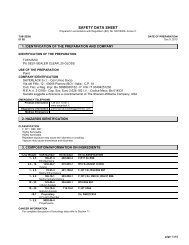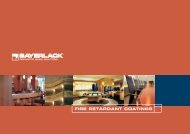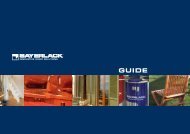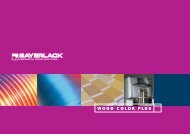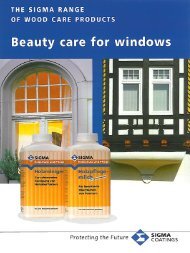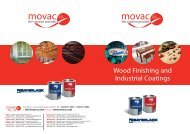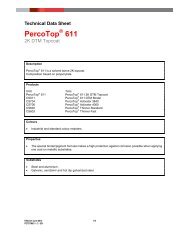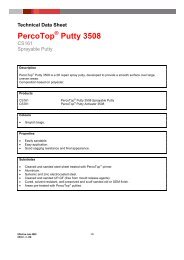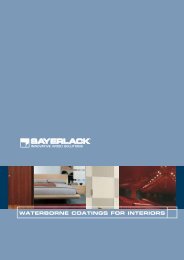Sayerlack Kitchen Coatings - Movac Group Limited
Sayerlack Kitchen Coatings - Movac Group Limited
Sayerlack Kitchen Coatings - Movac Group Limited
Create successful ePaper yourself
Turn your PDF publications into a flip-book with our unique Google optimized e-Paper software.
COATINGS FOR<br />
KITCHEN FURNITURE<br />
IN COMPLIANCE<br />
WITH UNI<br />
REGULATION<br />
11216 AND<br />
FIRA 6250
COATINGS FOR KITCHEN FURNITURE<br />
IN COMPLIANCE WITH UNI REGULATION 11216<br />
Performance requirements for painted wood surfaces<br />
UNI regulation 11216 defines performance standards for the finish;<br />
this allows users of the coatings to offer their customers a performance<br />
guarantee (for example, durability over time without deterioration or<br />
variation in colour gloss, scratch resistance, etc.).<br />
UNI (Italian Unification Agency) is an association made up of over 7,000<br />
associates (companies, freelancers, certification bodies, etc.) which<br />
passes regulations: texts defining product characteristics (performance,<br />
safety, environmental, etc.) that are the result of work by tens of thousands<br />
of experts in Italy and the world. The regulations in question are voluntarily<br />
and not mandatorily enforced, but play a highly important role in certifying<br />
the quality of products (one thinks for instance of the international ISO<br />
certifications).<br />
<strong>Sayerlack</strong> considers it essential to guarantee to its clients products of<br />
the highest quality. To this end it has decided to test the quality of its<br />
products, carrying out, within the Research and Development Laboratory,<br />
all tests provided for by the UNI 11216 regulation. Assessment criteria<br />
were identical to those used by the foremost certifying bodies, with which<br />
<strong>Sayerlack</strong> continually collaborates.<br />
The laboratory tests have enabled the selection of a series of coating<br />
systems that are in compliance with the regulatory standard.<br />
The regulation provides for various performance requirements, distinguishing<br />
three categories depending on target use: kitchen, bathroom, living-room<br />
and bedroom furniture. Each category comprises various performance<br />
requirements, depending on whether the surfaces in question are horizontal<br />
or vertical. In addition, domestic kitchen furniture is covered by specific<br />
performance requirements relating to worktops.<br />
The performance features of the products are ensured by laboratory tests.<br />
UNI Regulation 11216 takes into consideration the following characteristics:<br />
scratch resistance, resistance to fluctuations of temperature, resistance<br />
to dry heat, resistance to wet heat, cross-cut, adhesion through traction,<br />
resistance to cold liquids, resistance to light, tendency to retain dirt.
Description of laboratory<br />
tests carried out<br />
Determination of scratch resistance (UNI 9428)<br />
The value of scratch resistance is evaluated through determining the minimum load necessary, expressed in Newton,<br />
applied to a diamond tip, for the production of a visible, continuous circular mark on the surface of the prototype, fixed<br />
on a rotating plate with a velocity of 0.5 revolutions per minute.<br />
Determination of surface resistance to fluctuations of temperature (UNI 9429)<br />
Coated substrates are subjected to a heat system with temperatures and profiles set by the regulatory standard, and any alterations of the<br />
surfaces being tested are visually assessed.<br />
Measurement of surface resistance to dry heat (UNI EN 12722)<br />
The resistance of surfaces to dry heat is measured.<br />
A standardised block of aluminium alloy is placed, at a specified testing temperature, in direct contact with the surface of the panel being tested.<br />
After a specified length of time the block is removed and, after 16 hours have elapsed, any potential signs of damage to the area being tested<br />
are assessed.<br />
Measurement of surface resistance to wet heat (UNI EN 12721)<br />
The resistance of surfaces to wet heat is measured. A standardized block of aluminum alloy is placed, at a specified testing<br />
temperature and for a specified length of time, on top of a damp cloth that is in contact with the surface of the panel being<br />
tested. After 16 hours, any signs of damage to the area being tested are assessed.<br />
Measurement of adhesion through cross-cut (UNI EN ISO 2409)<br />
This test is carried out on surfaces covered with a coating film with a thickness of less than 250 μm.<br />
The test consists in applying a surface grid, composed of cross-cuts, onto the specimen surface, using appropriate<br />
sharp-bladed instruments. The choice of the most suitable instrument (variable spacing between the blades of 1 mm,<br />
2 mm e 3 mm) depends upon the type of substrate and on the thickness of the coating film.<br />
Calibrated adhesive tape is applied to the grid; the tape is then removed by being torn off; a visual assessment is then<br />
made of the amount of material removed. The six-level classification quoted by the regulatory standard is used.<br />
Measurement of adhesion through traction (UNI 9240)<br />
In contrast to the previous test, this test is carried out on surfaces to which coatings with a greater thickness are applied (coating films above<br />
250 μm). Adhesion of topcoats to the substrate is assessed with a traction test that determines the force necessary to tear off appropriate<br />
aluminium cylinders previously glued on.<br />
Measurement of surface resistance to cold liquids<br />
(UNI EN 12720)<br />
The prototypes are left in contact with a series of staining substances in common use in daily life (coffee, olive<br />
oil, ammonia solution, etc) according to durations and conditions of contact specified by the regulation. The<br />
prototypes are subsequently washed and examined in order to check any stains remaining on the surface. The<br />
classification is in relation to the resistance capacities of coated surfaces in the event of contact with chemical<br />
substances classified in six groups (from A to F).<br />
Determination of surface resistance to light (UNI 9427)<br />
Resistance to light is determined by exposing a prototype to radiations produced by an artificial source with features characteristic of a<br />
stable system, reproducing and verifying any potential variations in surface colour brought about by sunlight. The test is carried out in<br />
a room containing a Xenon lamp, whose light is filtered through two boron-silicate filters (in order to simulate the effect of being behind<br />
glass). In accordance with the regulation, exposure lasts 20 hours, at the end of which the specimen is assessed by at least three expert<br />
observers with the use of D65 lamps, who compare the zone exposed to the light with a non-exposed zone. The contrast obtained<br />
is compared with the grey scale (G/S) in accordance with ISO regulation 105 A 02; a “light/dark” scale that goes from 1 (considerable<br />
contrast, hence considerable colour variation) to 5 (no visible variation). The test is repeated on a specimen made of a white tile on<br />
which the coating is applied, in order to demonstrate that the coating does not yellow.<br />
Determination of surface tendency to retain dirt (UNI 9300)<br />
An appropriate mixture (carbon black or titanium dioxide in paraffin oil suspension) is rubbed onto the surface being tested, and, after<br />
a thorough cleaning of the surface with a specified detergent solution is carried out, the residual dirt is measured. At the end of the<br />
test, a visual assessment is made and a test grade is assigned in relation to the effect obtained.
SYSTEMS IN COMPLIANCE WITH UNI REGULATION 11216<br />
WATER-BASED COATING SYSTEMS<br />
Horizontal and vertical surfaces<br />
Stain AP 1221/XX<br />
Sealer AU 476/00 + 10% AH 1550/00<br />
Basecoat AU 472/00 + 10% AH 1545/00<br />
Topcoat AT 96**/NN + 1% XA 4080/00 + 3% XA 4095/00<br />
Stain AP 1221/XX<br />
Sealer AU 476/00 + 10% AH 1550/00<br />
Basecoat AU 472/00 + 10% AH 1545/00<br />
Topcoat AT 99**/NN + 1% XA 4080/00 + 3% XA 4095/00<br />
Stain AP 1221/XX<br />
Basecoat (2 coats) AU 472/00 + 10% AH 1545/00<br />
Topcoat AT 96**/NN + 1% XA 4080/00 + 3% XA 4095/00<br />
Stain AP 1221/XX<br />
Basecoat (2 coats) AU 465/00<br />
Topcoat AT 96**/NN + 1% XA 4080/00 + 3% XA 4095/00<br />
Stain AP 1221/XX<br />
Sealer AU 476/00 + 10% AH 1550/00<br />
Basecoat AU 472/00 + 10% AH 1545/00<br />
Topcoat AF 72**/00 + 1% XA 4080/00 + 3% XA 4095/00<br />
WATER-BASED COATING SYSTEMS<br />
Vertical surfaces<br />
Stain AP 1221/XX<br />
Sealing Basecoat (2 coats) AU 476/00 + 10% AH 1550/00<br />
Topcoat AT 96**/NN + 1% XA 4080/00 + 3% XA 4095/00<br />
Stain AP 1221/XX<br />
Sealer AU 476/00 + 10% AH 1550/00<br />
Basecoat AU 465/00<br />
Topcoat AT 96**/NN + 1% XA 4080/00 + 3% XA 4095/00<br />
MIXED SYSTEMS<br />
Horizontal and vertical surfaces<br />
Stain AP 1221/XX<br />
Basecoat (2 coats) AU 472/00 + 10% AH 1545/00<br />
Topcoat TZ 36**/00 + 70% TH 759/00<br />
SOLVENT-BASED COATING SYSTEMS<br />
Horizontal and vertical surfaces<br />
Isolante TU 250/00 + 10% TH 790/00<br />
Basecoat (2 coats) PU 361/13 + 2% PH 888/00 + 2% PH 999/00<br />
Topcoat TL 335/A1+ 80% TH 735/00<br />
Basecoat (2 coats) TU 4132/00 + 50% TH 727/00<br />
Topcoat TZ 90**/00 + 50% TH 773/00<br />
Basecoat (2 coats) TU 54/00 + 20% TH 790/00<br />
Topcoat TZ 93**/00 + 20% TH 790/00<br />
Sealer TU 250/00 + 10% TH 790/00<br />
Basecoat (2 coats) PU 386/00 + 2% PH 888/00 + 2% PH 999/00<br />
Topcoat TL 335/00 + 80% TH 735/00<br />
Sealer TU 250/00 + 10% TH 790/00<br />
Basecoat (2 coats) PU 6019/00 + 2% PH 888/00 + 2% PH 999/00<br />
Topcoat TL 335/00 + 80% TH 735/00<br />
Basecoat (2 coats) TU 4132/00 + 50% TH 727/00<br />
Topcoat TZ 62**/00 + 70% TH 759/00<br />
Basecoat (2 coats) TU 4132/00 + 50% TH 727/00<br />
Topcoat TZ 37**/00 + 70% TH 759/00<br />
Sealer TU 250/00 + 10% TH 790/00<br />
Basecoat (2 coats) PU 361/13 + 2% PH 888/00 + 2% PH 999/00<br />
Topcoat TZ 88**/A1 + 70% TH 759/00<br />
Sealer TU 250/00 + 10% TH 790/00<br />
Basecoat (2 coats) PU 637/13 + 2% PH 888/00 + 2% PH 999/00<br />
Topcoat TL 335/A1 + 80% TH 735/00<br />
Sealer TU 250/00 + 10% TH 790/00<br />
Basecoat (2 coats) TU 148/13 + 40% TH 780/00<br />
Topcoat TZ 88**/A1 + 70% TH 759/00<br />
SOLVENT-BASED COATING SYSTEMS<br />
Vertical surfaces<br />
Sealer TU 250/00 + 10% TH 790/00<br />
Basecoat (2 coats) TU 160/00 + 50% TH 727/00<br />
Topcoat TZ 37**/00 + 50% TH 711/00<br />
Basecoat (2 coats) TU 4132/00 + 50% TH 727/00<br />
Topcoat TZ 29**/00 + 50% TH 773/00<br />
WATER-BASED UV COATING SYSTEMS<br />
Horizontal and vertical surfaces<br />
Basecoat RA 355/0O<br />
Topcoat AR 70**/00<br />
SOLVENT-BASED UV COATING SYSTEMS<br />
Horizontal and vertical surfaces<br />
Basecoat (2 coats) RU 7424/13<br />
Topcoat RL 8805/74<br />
Basecoat (2 coats) RU 7424/13<br />
Topcoat RL 8857/13
HIGH PERFORMANCE SYSTEMS<br />
Certain coating systems on which tests were carried out yielded optimum performance results, close to the level required<br />
by the regulation.<br />
The systems in question are ones that do not yet conform to UNI Regulation 11216 but are recommended by <strong>Sayerlack</strong>,<br />
insofar as over 95% of the tests carried out satisfy the performance requirements called for.<br />
WATER-BASED COATING SYSTEMS<br />
Horizontal surfaces<br />
(for vertical surfaces, the systems are in compliance with the regulation)<br />
Stain AP 1221/XX<br />
Sealing Basecoat (2 coats) AU 476/00 + 10% AH 1550/00<br />
Topcoat<br />
AT 96**/NN + 1% XA 4080/00 +<br />
3% XA 4095/00<br />
Stain AP 1221/XX<br />
Sealer AU 476/00 + 10% AH 1550/00<br />
Basecoat AU 465/00<br />
AT 96**/NN + 1% XA 4080/00 +<br />
Topcoat<br />
3% XA 4095/00<br />
WATER-BASED COATING SYSTEMS<br />
Horizontal and vertical surfaces<br />
Ti Stain AP 1221/XX<br />
Self-Sealer (3 coats) AF 60**/00 + 10% AH 1547/00<br />
WATER-BASED COATING SYSTEMS<br />
Vertical surfaces<br />
Stain AP 1221/XX<br />
Sealer AU 476/00 + 10% AH 1550/00<br />
Basecoat AU 472/00 + 10% AH 1545/00<br />
Topcoat AT 48**/00 + 10% AH 1545/00<br />
Stain AP 1221/XX<br />
Sealing Basecoat (2 coats) AU 476/00 + 10% AH 1550/00<br />
Topcoat AT 48**/00 + 10% AH 1545/00<br />
MIXED SYSTEMS<br />
Horizontal and vertical surfaces<br />
Stain AP 1221/XX<br />
Sealing Basecoat (2 coats) AU 476/00 + 10% AH 1550/00<br />
Topcoat TZ 36**/00 + 70% TH 759/00<br />
MIXED SYSTEMS<br />
Vertical surfaces<br />
Fond (2 couches) TU 325/00 + 100% TH 146/00<br />
Topcoat AF 60**/00 + 10% AH 1547/00<br />
Stain AP 1221/XX<br />
Basecoat (2 coats) TU 4132/00 + 50% TH 780/00<br />
Topcoat<br />
AT 99**/NN + 1% XA 4080/00 +<br />
3% XA 4095/00<br />
Stain AP 1221/XX<br />
Basecoat (2 coats) TU 4132/00 + 50% TH 780/00<br />
AF 72**/00 + 1% XA 4080/00 +<br />
Topcoat<br />
3% XA 4095/00<br />
MIXED UV SYSTEMS<br />
Horizontal and vertical surfaces<br />
Sealer RU 382/00<br />
Basecoat (2 coats) RU 362/00<br />
Topcoat AR 77**/00<br />
Stain AP 1221/XX<br />
Sealer AU 476/00 + 10% AH 1550/00<br />
Basecoat AU 465/00<br />
Topcoat AT 48**/00 + 10% AH 1545/00<br />
Basecoat (2 coats) AU 472/13 + 5% AH 1550/00<br />
Topcoat<br />
AT 96**/NN + 1% XA 4080/00 +<br />
3% XA 4095/00 + XA 2006/XX<br />
Basecoat (2 coats) AU 472/13 + 5% AH 1550/00<br />
AT 96**/BB + 1% XA 4080/00 +<br />
Topcoat<br />
3% XA 4095/00 + XA 2006/XX<br />
For the correct production of the coating systems<br />
listed in this brochure, please refer to the products<br />
Technical Data Sheets or contact <strong>Sayerlack</strong> Technical<br />
Service.
COATINGS FOR<br />
KITCHEN FURNITURE<br />
IN COMPLIANCE<br />
WITH UNI<br />
REGULATION<br />
11216<br />
Minimum requirements for kitchen furniture are indicated<br />
in the following table:<br />
MINIMUM<br />
REQUIREMENTS<br />
TEST<br />
TESTING<br />
METHOD<br />
UNIT OF MEASURE /<br />
CLASS / LEVEL<br />
Working<br />
plan<br />
Other<br />
horizontal<br />
surfaces<br />
Vertical<br />
surfaces<br />
Scratch resistance UNI 9428 N > 2 > 0,6 > 0,6<br />
Resistance to temperature fluctuations UNI 9429 Level 5 5 5<br />
Dry heat resistance UNI EN 12722 Class according to UNI 10944 B D /<br />
Wet heat resistance UNI EN 12721 Class according to UNI 10944 A C /<br />
Adhesion per dry coating thickness a)<br />
1) thickness < 0,250 mm – cross-cut test<br />
2) thickness > 0,250 mm – traction test<br />
UNI EN ISO 2409<br />
UNI 9240<br />
ISO Scale<br />
MPa<br />
< 1<br />
< 1<br />
< 1<br />
> 1,2 b) > 1,2 b)<br />
> 1,2 b)<br />
Surface resistance to cold liquids UNI EN 12720 Class according to UNI 10944 B C D<br />
Surface resistance to light:<br />
UNI 9427<br />
Light lacquers c)<br />
Dark lacquers d)<br />
Light colour wood e)<br />
Dark colour wood f)<br />
Grey Scale<br />
Grey Scale<br />
Grey Scale<br />
Grey Scale<br />
4/5 g)<br />
5 h)<br />
2/3<br />
4<br />
4/5 g)<br />
5 h)<br />
2/3<br />
4<br />
4/5 g)<br />
5 h)<br />
2/3<br />
4<br />
Tendency to retain dirt UNI 9300 Level 4 4 4<br />
a) Thickness as measured according to UNI EN ISO 2808.<br />
b) The requirement is not applicable if the test determines the delamination of the panel with a force < 1,2 MPa.<br />
c) Light lacquer with a value of Y > 15 as measured according to UNI 8941-2.<br />
d) Dark lacquer with a value of Y < 15 as measured according to UNI 8941-2.<br />
e) By ‘’light wood’’ is meant a coated wooden surface with a value of Y > 15 as measured according to UNI 8941-2.<br />
f ) By ‘’dark wood’’ is meant a coated wooden surface with a value of Y < 15 as measured according to UNI 8941-2.<br />
g) Potential variations in colour can be instrumentally carried out according to UNI 8941-3.<br />
The requirement in accordance with UNI EN ISO 105-A05 is: 0,40 < < 1,25.<br />
h) Potential variations in colour can be instrumentally carried out according to UNI 8941-3.<br />
The requirement in accordance with UNI EN ISO 105-A05 is: < 0,40.
COATINGS FOR<br />
KITCHEN FURNITURE<br />
IN COMPLIANCE<br />
WITH<br />
FIRA 6250<br />
Clear Water Based Lacquers<br />
FIRA 6250 - TEST RESULTS<br />
Arch <strong>Coatings</strong> assumes no contractual liability or responsibility in regards to the texts and photographs included herein.<br />
TEST<br />
FIRA 6250<br />
severe test<br />
standards<br />
AF 7220<br />
no.<br />
XA 4080<br />
AF 7240<br />
+ 1%<br />
XA 4080<br />
AT 9930<br />
no.<br />
XA 4080<br />
AT 9930<br />
+ 0,5%<br />
XA 4080<br />
AT 9930<br />
+ 1%<br />
XA 4080<br />
AU 472 +<br />
AT 4820<br />
+ 10%<br />
AH 1550<br />
Crosscut 4 4 5 4 4 4 5<br />
Scrape, Surface Penetration 3 4 5 4 3 4 3<br />
Penetration to substrate 4 4 5 5 3* 4 4<br />
Impact 3 5 5 5 4 4 4<br />
Wet Heat 55°C 3 5 5 5 5 4 3<br />
Wet Heat 70°C 2 5 5 4 4 4 3<br />
Wet Heat 85°C 2 4 5 3 3 3 3<br />
Dry Heat 85°C 3 5 5 3 3 3 3<br />
Dry Heat 100°C 3 5 5 3 3 3 3<br />
Acetone 3 3 2* 3 4 4 4<br />
Ethanol 96% / Toilet Spirit 3 3 5 3 4 4 4<br />
Ethanol 48% / Potable Spirit 4 3* 5 3* 4 4 4<br />
Tea 5 5 5 5 5 5 5<br />
Coffee 5 5 5 5 5 5 5<br />
Cold Oils 4 5 5 5 5 5 5<br />
Cold Fats 4 5 5 5 5 5 5<br />
**Disinfectant / Phenol 3 5 5<br />
**Disinfectant / Chloro 3 5 5<br />
**Paraffin Oil 3 5 5<br />
**Blackcurrant Juice 3 5 5<br />
**Ammonia 3 2* 2*<br />
**Acetic Acid 3 5 5<br />
**Olive Oil 3 5 5<br />
**Bathroom test specification<br />
*Signifies below level required<br />
SEVERE<br />
PASS<br />
SEVERE<br />
PASS<br />
SEVERE<br />
PASS<br />
SEVERE<br />
PASS<br />
SEVERE<br />
PASS<br />
SEVERE<br />
PASS<br />
Test allows for two 1 point failures and still qualifies for severe rating.<br />
PRODUCT KEY<br />
AF 72** RANGE<br />
AT 99** RANGE<br />
AT 48** RANGE<br />
Waterbased Self Crosslinking Topcoat (and Coat on Coat) Clear<br />
Waterbased High Build Self Crosslinking Topcoat Clear and White<br />
NEW Waterbased 2 pack Polyurethane Clear and White<br />
10/2008<br />
Z02A18UK-MOVAC<br />
absolut
DELIVERING YOUR BUSINESS SOLUTION<br />
SAYERLACK’S LARGEST UK DISTRIBUTOR<br />
& LEADING EUROPEAN DISTRIBUTOR<br />
<strong>Movac</strong> are <strong>Sayerlack</strong>’s longest serving and largest UK<br />
Distributor. We have six depots, with 8 Field based Technical<br />
Representatives & 90+ staff. <strong>Movac</strong> operate 25 vehicles offering<br />
a scheduled daily delivery service throughout ‘<strong>Movac</strong>land’ (as<br />
we call it) and we can courier your orders throughout the UK<br />
and Europe.<br />
<strong>Movac</strong>land<br />
<strong>Movac</strong> have the latest COROB automatic mixing machinery<br />
at every depot, with an impressive centralised library of colour formulations. Every<br />
<strong>Movac</strong> Depot has a Spectrophotometer to enable us to identify and match your colour<br />
quickly, accurately and manufacter high quality paints consistently.<br />
<strong>Movac</strong>’s success in the wood finish industry has come from a determination to<br />
be the best for your business and to give you the right solution. We can<br />
design systems for you, mix bespoke colour in any quantity, and advise on<br />
the best product systems, both in terms of speed and effieciency, coupled with the best<br />
environmental products in the UK today. We can train your staff on-site, or at our<br />
Training Facility in Norwich, on the use of these systems, enabling your company to<br />
maximise the benefits of these systems.<br />
<strong>Movac</strong> stock <strong>Sayerlack</strong>’s products for Wood Finish, Glass and Plastics, both for<br />
Internal and External markets. We were the first distributors of <strong>Sayerlack</strong>’s products<br />
in the UK, and we have gained an enormous wealth of knowledge in the brand.<br />
Collectively our Field Staff have over 150 years of experience in the trade, and as most<br />
of them have trained in the industry, they really do understand your business needs.<br />
<strong>Movac</strong>’s portfolio is extensive, keeping pace with the needs of our customers<br />
and the ever improving technologies and application requirements. <strong>Movac</strong><br />
supply a vast range of over 100,000 product lines including spray equipment,<br />
pumps, spares, tools, wipers, janitorial supplies, waste removal, masking<br />
tapes and papers, the list goes on.<br />
When you need world class products delivered promptly, choose<br />
<strong>Movac</strong>, the Solution Provider.<br />
Head Office Telephone Number: + 44 84 45 61 00 70<br />
Go to our website for details www.movac.com<br />
Arch coatings UK Ltd - A1 Business Park - Knottingley - West Yorkshire - WF11 0BU - England<br />
tel. +44 (0) 1977 673363 - fax +44 (0) 1977 673521 - email: info@archcoatings.co.uk - www.sayerlack.co.uk<br />
Technical Service - tel. +39 051 770770 - fax +39 051 770521 - customerservice@sayerlack.it



